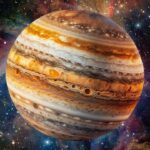The cosmos has always been a source of wonder and amazement for humanity, and recent advancements in technology have allowed us to explore its mysteries like never before. NASA’s James Webb Space Telescope has been capturing breathtaking images of the universe, revealing stunning details that are both mesmerizing and informative.
One of the most captivating images shared by NASA is the deep field mosaicked view of galaxy cluster Abell 2744, also known as Pandora’s Cluster. This cluster, located 3.5 billion light-years away, showcases the beauty and complexity of our universe. Dominated by dark matter, the cluster distorts spacetime, gravitationally lensing distant objects and creating mesmerizing lensed images of galaxies from the early universe.
The images from the James Webb Space Telescope offer a glimpse into the cosmic phenomena that shape our universe. Astronomers and scientists are thrilled by the sharpness and level of detail in each image, providing insights into the formation of stars, galaxies, and nebulae. The telescope’s ability to reveal structures that were previously hidden from view is expanding our understanding of the cosmos.
Furthermore, the James Webb Space Telescope has the potential to make groundbreaking discoveries in the coming years. With its advanced technology and unparalleled imaging capabilities, the telescope is set to revolutionize our knowledge of the universe. From studying the formation of stars and galaxies to identifying habitable planets beyond our solar system, the possibilities are endless.
As the world marvels at the stunning images shared by NASA, it is clear that we are on the brink of a new era in space exploration. The detailed and intricate visuals captured by the James Webb Space Telescope are a testament to human ingenuity and curiosity, driving us to reach for the stars and unlock the secrets of the cosmos.







